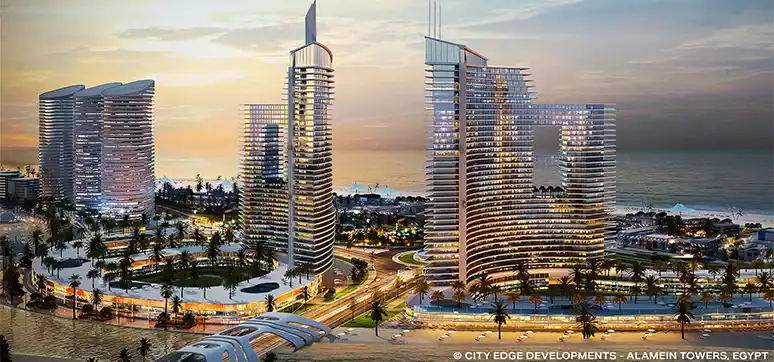What is the demand for glass in niche and low-rise applications?
Recently, glass has been used on building façades more frequently, accounting for a larger portion of the façade area. While this approach has been adopted for a while in a high-rise, commercial, and office buildings, we are now seeing it in residential and other domestic low-rise buildings as well.
The need for a better view of the outdoors and more natural daylight to enter the building is, in my opinion, the primary driver of such high demand for using more glass in façades. While improving daylighting entering through the façades can greatly reduce the need for artificial lighting and accordingly reduce the associated energy consumption and heat dissipation, however, increasing GWR (Glass to Wall Ratio) in buildings’ envelopes can have adverse effects such as increased solar heat gains and glare, particularly in hot climate zones like the Middle East and North Africa.

When it comes to glass, what would be your preferred specifications?
In terms of glass selection criteria, there is no recipe that can be used for all buildings’ envelopes; a variety of factors, such as the architecture itself, orientation, occupancy, interior design, and space function, among others, could have an impact. There will always be trade-offs between different performance aspects when it comes to design decisions related to glazing specifications. For example, increasing daylight means higher G-value and higher cooling loads; and using higher selectivity glass will increase the cost! On the other hand, increasing solar heat gains may be desirable in winter to reduce heating loads, but in summer it can significantly increase cooling loads.
That is why architects, façade consultants, HVAC and lighting engineers should work collaboratively, early in the design process, to balance these aspects and develop tailored and optimised solutions that best suit each project. Glass performance and selection criteria should eventually be based on the context in which the building exists as well as the behavior of building’s tenants and users.
What are the methods to select the right type of glazing? How this may impact energy consumption?
The first step is to understand the context, including the project’s location, surrounding built environment, and climate conditions. This can be achieved by developing Building Energy Models (BEM) to evaluate and compare the impact of different façade design/ specification options on building energy consumption, thermal comfort, amount of daylight entering through the façade, sunlight exposure, glare, air infiltration, and other factors.
The results of such simulations and analyses can provide a detailed picture of the potential synergies between a building’s façade, including glazing, and other building systems in order to achieve optimal performance. The more detailed the BEM, the more precise the results. Another factor to consider when choosing glazing types is cost. It is possible to mistakenly believe that adopting a strict specifications approach and using expensive higher performance glass (like triple glass units with solar coating) and/or higher selectivity (higher visible light transmittance and lower solar heat gains) is the only solution to dealing with climates similar to those in the MENA region.
While this will undoubtedly reduce heat gains and lower energy use, such an approach may have an unintended impact on cost as well as performance. There are numerous mitigating strategies that can be implemented to improve façade performance without incurring additional costs.

What are the methods to manage glare and overheating in buildings?
This is the subject of research being conducted by a group of pre-master’s students at the German University in Cairo – Architectural technology dept., sustainability division. (I, Prof. Michael Eichner, and Dr. Yasmina Sarhan are in charge of the supervision). The group chose one of the GUC’s design studio halls, which has three nearly totally glazed façades (North, East, and South), for the research project, which involves investigating the impact of using fully glazed façades on thermal performance in educational buildings.
While the architect planned for ample natural light in such a space and reduce the need for artificial lighting, the actual situation suggests otherwise. Most of the year, the hall has too much glare and harsh shadows (close to the periphery), accordingly indoor curtains are always closed, and lights are always switched on when the hall is in use.
The research group investigated the roots of these problems as well as potential solutions by developing a Building Energy model to assess the current situation and potential design options. Many ideas have been considered, including the installation of fixed sun breakers or fins on the southern façade curtain wall, the installation of a kinetic/adaptive façade shading system, and the use of electrochromic glass in place of the current glass. With each design alternative, Studio Hall’s solar heat gain and daylight have enhanced to varying degrees.
There are numerous ways for limiting glare and overheating (due to the usage of glass) in buildings, however, these strategies should be examined early in the design phase rather than after construction.

How do glass & glazing technologies increase the efficiency of building systems?
The glass industry’s technology evolves at a rapid pace, and the products on the market have excellent performance qualities, and when utilised correctly, they can improve the efficiency of all building systems like HVAC and lighting, etc. Solar control glass (which allows daylight to enter the building while controlling and reflecting solar heat away “UV and IR”), and Low E coatings (enhance thermal performance and reduce IGU U-Values) have been available for some time and play a great role in enhancing thermal comfort and reducing energy use, and they are still being developed to provide improved performance.
Furthermore, smart products such as thermochromic and electrochromic glass can be very effective as well; electrochromic smart glass, for example, changes its light transmittance through an electrical signal that varies based on the amount of solar lighting data obtained from sensors positioned on the façade. Such technologies can minimise cooling and heating loads, as well as optimise the use of artificial lighting based on the quantity of light entering the room.
What are the other Limitations of having fully glazed façades on buildings?
There are challenges rather than limitations, I suppose; in addition to the influence of glazing on the thermal performance as mentioned before there are certain additional aspects that need to be addressed and coordinated throughout all design and construction stages. Structural performance is an essential consideration. Fully glazed façades, or curtain walls, should carry their own weight, wind loads, access loads, impact, occupancy loads, etc., but also they should be designed to accommodate the primary structure’s movements such as deflections, drift, columns shortening, and so on. So, early coordination with structural engineers, as well as accurate detailing, specifications and calculations, and post-failure assessments, all play an important role in defining the structural integrity of the overall façade system, reducing risk, and alleviating safety concerns.
In terms of safety, what factors should be considered when selecting glass for façades or balustrades?
There are many, but I believe it should begin with choosing the right type of glass. Residents, architects, and engineers may be concerned about dealing with glass in general. Glass is a brittle material that can fail due to impact, thermal stresses, or even spontaneously. As a result, the appropriate type of glazing, whether laminated, toughened, heat strengthened, heat soak tested, or otherwise, must be chosen based on the location, slope, application, height, and risks involved.

It is also critical to evaluate the glass’s post-failure behaviour and the risk associated with it. For example, in certain markets, all outside panes of glazed façades are now specified as totally toughened glass. Toughened glass has more stiffness and compression resistance, and hence can resist higher wind loads with less thickness; less thickness implies a smaller glazing rebate, and thus a cheaper and lighter system! Toughened glass, on the other hand, is prone to spontaneous breaking due to NiS (Nickel sulphide) inclusions, and utilising such a configuration in high-rise buildings can be a recipe for a disaster, especially if pedestrian walkways exist beneath these buildings. You can imagine how much harm a 1 gram glass dice falling at 100 km/h may cause. It may be fatal if it fell on humans.
As for glass balustrades, ARKS designs façade team dealt with this issue in Alamein Towers project. The skyscrapers facing the seashore were ringed by balconies along the periphery to provide residents with good views and allow them to enjoy the weather. The balustrades were all designed as cantilever glass barriers. There are several safety issues to be considered; nevertheless, they can be summarised as follows:
-

City EDGE Developments, Alamein Towers EGYPT Glass barriers must resist design loads with an appropriate factor of safety.
- The displacement of the barrier under the action of design loads must be within acceptable limits that do not cause user discomfort or worry. And, in some cases, tighter displacement values should be adopted to allay residents’ fears.
- The glass barrier must be resistant to accidental impact. (Balcony depth can be a determinant factor when deciding the required level of resistance/ performance)
- Post-failure behaviour should be assessed and deemed safe. That is, the balustrade should provide containment in the event of a break.
- Standards such as BS 6206, BS 6262, BS 6180, and BS EN 12600, among others, offer guidance on the minimum required performance and testing techniques. The design and performance criteria of glazed barriers are also comprehensively discussed in CWCT’s guidance and technical notes.
What are the trends that can be seen in architectural glass in the coming years in your region?
Egypt’s real estate sector, and the building industry in general, are expanding rapidly. At the same time as the Egyptian government is phasing out energy subsidies as part of its economic reform agenda, the administration is also taking meaningful steps to reduce carbon emissions. This can increase the demand for more sustainable buildings and cities, encouraging building owners and developers to use more efficient façade systems in their projects.
Although there is still a lack of regulations and codes that require specific levels of façade performance, energy consumption, and carbon emissions, we see façade systems suppliers and glass manufacturers are attempting to provide high performance products with very competitive prices in order to encourage and persuade buildings owners to switch to a more sustainable alternatives.














